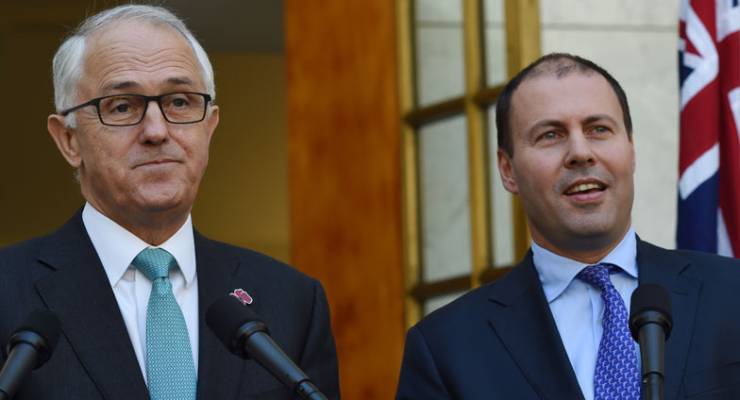
Today’s release of the terms of reference for the government’s climate change policy review has yet again sparked discussion about whether the government will embrace some form of trading scheme to enable it to achieve its emissions abatement targets. But at some point commentators and industry are going to have to accept the reality: whatever Malcolm Turnbull’s rhetoric, this is a do-nothing government running climate denialist policies inherited from a climate denialist predecessor.
Courtesy of its ratification of the Paris agreement a month ago, the government is now formally committed, in a binding international deal, to reducing greenhouse emissions by 26-28% below 2005 levels by 2030 — a target far below the level identified by the Climate Commission as needed to meet the Paris Agreement goal of keeping global temperatures to below 2 degrees above pre-industrial levels (in fact, the agreement was for temperatures “well below” that level, ideally 1.5 degrees). In the Climate Commission’s view, 45-63% by 2030 was a more appropriate target.
Problem is, the government has no policy mechanism for meeting that target. Energy Minister Josh Frydenberg tacitly acknowledges that in today’s media release, despite laughably claiming “Australia’s effective climate change policies are working”. The point of the review, to be conducted next year by the Department of Energy, is to “ensure policies remain effective in achieving Australia’s 2030 target and Paris Agreement commitments”.
As everyone knows — although the government refuses to state it — its primary policy, the Emissions Reduction Fund (ERF) — or what used to be called “Direct Action” — can, on current funding levels, only deliver a small fraction of the required abatement (and much of it would have been undertaken anyway without government funding).
A calculation by the Climate Institute based on the first two ERF auctions suggested it would only deliver 14% of the needed abatement. Other calculations confirm the ERF is woefully inadequate; the long-haired hippies at the Australian Industry Group calculated, based on the first ERF auction, that up to a quarter of a trillion dollars would be required for the ERF to reach the new government’s target. A recent analysis by the Green Institute pointed out that the ERF — which relies heavily on the agricultural sector for abatement — would only offset 20% of the increased emissions caused by land clearing between now and 2030. So “soil magic” won’t even stop us from going backward.
[Even rain can’t stop the parade on day one of Morocco climate conference]
A partial solution, for a while, looked to be converting the laughable baseline safeguard scheme that was supposed to accompany the ERF into a de facto trading mechanism. Then-junior industry minister Greg Hunt tried to claim the mechanism would deliver nearly a quarter of the needed abatement. But that simply, mathematically, can’t happen without the emissions baselines that are central to the scheme (before any number of exemptions, loopholes and concessions kick in to remove any problems for firms exceeding baselines) being significantly lowered over time.
Then there was the pre-election kerfuffle that perhaps permit trading would be permitted under the mechanism, which Hunt angrily denied — along with denying the baselines would ever fall.
Between them and today’s announcement of a review next year, there’s been nothing: Hunt was promoted to senior Industry Minister, while his replacement, Energy Minister and coal spruiker Frydenberg talked vaguely about “extending the National Energy Productivity Plan, which is designed to boost productivity and efficiency by 40% by 2030, as well as vehicle emissions and a number of other changes”.
The problem is that any genuine policy change that might achieve even the government’s underwhelming targets will be killed off by the right within the Liberal Party and the Nationals. For example, if the review (which will be controlled by Frydenberg and Energy Department bureaucrats) magically recommended that the emissions baseline safeguard mechanism be de-Huntified and actually made into a serious regulatory mechanism, that would be fought tooth and claw by industry and the right; if it went further and urged that some form of trading scheme be allowed for companies exceeding their baselines to purchase credits from companies undershooting theirs, it would be seen entirely through the prism of the split between Turnbull and the arch-reactionaries among his colleagues.
[Whisper it softly: is this government any better than Abbott’s?]
And given Turnbull’s history of giving in to every single demand from the right so far, does anyone seriously think he’s up to the task of implementing something that even faintly smacks of Abbott’s “great big new tax on everything”?
The only alternative will be inefficient, expensive taxpayer intervention — investment in renewables, handouts to shut down coal-fired power stations and to transmission and distribution owners to gold-plate energy systems in the name of “energy security”.
But industry and commentators should give up on the fantasy that this government will ever embrace high-quality emissions abatement policies. It would require strong, competent leadership from the Prime Minister, and sadly there’s been little of that so far.








Crikey is committed to hosting lively discussions. Help us keep the conversation useful, interesting and welcoming. We aim to publish comments quickly in the interest of promoting robust conversation, but we’re a small team and we deploy filters to protect against legal risk. Occasionally your comment may be held up while we review, but we’re working as fast as we can to keep the conversation rolling.
The Crikey comment section is members-only content. Please subscribe to leave a comment.
The Crikey comment section is members-only content. Please login to leave a comment.